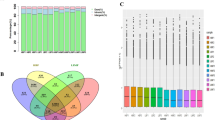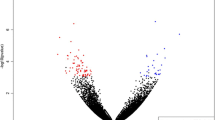Abstract
Lipid deposition, especially in subcutaneous (backfat) adipose tissues, is directly related to the meat yield and quality in pork. We hypothesized that differentially expressed genes and their transcription factors play a role in the regulation of adipogenesis in porcine backfat. We identified 136 differentially expressed genes (DEGs) in subcutaneous adipose tissue between two pig breeds, the Korean native pig (KNP) and Yorkshire, using a cDNA microarray. Gene ontology analysis demonstrated that some DEGs are involved in fat metabolism processes such as adipogenesis, adipocyte differentiation, and lipolysis. In addition, we identified the regulatory relationship between DEGs and their transcription factors using in silico and qRT-PCR analysis. Two transcription factors (TEF-1, IRF-7) have positively regulated DEGs in KNP backfat. Three other transcription factors (STAT3, OCT1 and HNF4) are negatively correlated with the DEGs in KNP backfat. Our findings suggest that DEGs and their transcription factors may have a potential role in adipogenesis and/or lipid deposition in backfat tissues between pig breeds.
Similar content being viewed by others
References
Cao Y (2007) Angiogenesis modulates adipogenesis and obesity. J. Clin. Invest. 117: 2362–2368.
Choe SE, Boutros M, Michelson AM, Church GM and Halfon MS (2005) Preferred analysis methods for Affymetrix GeneChips revealed by a wholly defined control dataset. Genome Biol. 6: R16.
Cobanoglu O, Zaitoun I, Chang Y, Shook G and Khatib H (2006) Effects of the signal transducer and activator of transcription 1 (STAT1) gene on milk production traits in Holstein dairy cattle. J. Dairy Sci. 89: 4433–4437.
Cope LM, Irizarry RA, Jaffee HA, Wu Z and Speed TP (2004) A benchmark for Affymetrix GeneChip expression measures. Bioinformatics 20: 323–331.
Eguchi J, Yan QW, Schones DE, Kamal M, Hsu CH, Zhang MQ, Crawford GE and Rosen ED (2008) Interferon regulatory factors are transcriptional regulators of adipogenesis. Cell Metab. 7: 86–94.
Exton JH and Park CR (1969) Control of gluconeogenesis in liver. 3. Effects of L-lactate, pyruvate, fructose, glucagon, epinephrine, and adenosine 3′,5′-monophosphate on gluconeogenic intermediates in the perfused rat liver. J. Biol. Chem. 244: 1424–1433.
Greenfield NJ, Kostyukova AS and Hitchcock-DeGregori SE (2005) Structure and tropomyosin binding properties of the N-terminal capping domain of tropomodulin 1. Biophys. J. 88: 372–383.
Hausman GJ, Barb CR and Dean RG (2008) Patterns of gene expression in pig adipose tissue: insulin-like growth factor system proteins, neuropeptide Y (NPY), NPY receptors, neurotrophic factors and other secreted factors. Domest. Anim. Endocrinol. 35: 24–34.
Hausman GJ and Richardson RL (2004) Adipose tissue angiogenesis. J. Anim. Sci. 82: 925–934.
Hochreiter S, Clevert DA and Obermayer K (2006) A new summarization method for Affymetrix probe level data. Bioinformatics 22: 943–949.
Huang da W, Sherman BT and Lempicki RA (2009) Systematic and integrative analysis of large gene lists using DAVID bioinformatics resources. Nat. Protoc. 4: 44–57.
Imhoff BR and Hansen JM (2010) Extracellular redox environments regulate adipocyte differentiation. Differentiation 80: 31–39.
Irizarry RA, Hobbs B, Collin F, Beazer-Barclay YD, Antonellis KJ, Scherf U and Speed TP (2003) Exploration, normalization, and summaries of high density oligonucleotide array probe level data. Biostatistics 4: 249–264.
Jell J, Merali S, Hensen ML, Mazurchuk R, Spernyak JA, Diegelman P, Kisiel ND, Barrero C, Deeb KK, Alhonen L, et al. (2007) Genetically altered expression of spermidine/spermine N1-acetyltransferase affects fat metabolism in mice via acetyl-CoA. J. Biol. Chem. 282: 8404–8413.
Kim SS, Kim JR, Moon JK, Choi BH, Kim TH, Kim KS, Kim JJ and Lee CK (2009) Transcriptional alteration of p53 related processes as a key factor for skeletal muscle characteristics in Sus scrofa. Mol. Cells 28: 565–573.
Liefoodghe A, Touzet H and Varre JS (2006) Large scale matching for Position Weight Matrices. Springer, pp. 401–412.
Lijnen HR (2008) Angiogenesis and obesity. Cardiovasc. Res. 78: 286–293.
Littlefield R, Almenar-Queralt A and Fowler VM (2001) Actin dynamics at pointed ends regulates thin filament length in striated muscle. Nat. cell biol. 3: 544–551.
Liu WM, Mei R, Di X, Ryder TB, Hubbell E, Dee S, Webster TA, Harrington CA, Ho MH, Baid J, et al. (2002) Analysis of high density expression microarrays with signed-rank call algorithms. Bioinformatics 18: 1593–1599.
Ma T, Jayaraman S, Wang KS, Song Y, Yang B, Li J, Bastidas JA and Verkman AS (2001) Defective dietary fat processing in transgenic mice lacking aquaporin-1 water channels. Am. J. Physiol. Cell Physiol. 280: C126–134.
Mash DC, ffrench-Mullen J, Adi N, Qin Y, Buck A and Pablo J (2007) Gene expression in human hippocampus from cocaine abusers identifies genes which regulate extracellular matrix remodeling. PLoS ONE 2: e1187.
Matys V, Fricke E, Geffers R, Gossling E, Haubrock M, Hehl R, Hornischer K, Karas D, Kel AE, Kel-Margoulis OV et al. (2003) TRANSFAC: transcriptional regulation, from patterns to profiles. Nucleic Acids Res. 31: 374–378.
McClain DA, Lubas WA, Cooksey RC, Hazel M, Parker GJ, Love DC and Hanover JA (2002) Altered glycan-dependent signaling induces insulin resistance and hyperleptinemia. Proc. Natl. Acad. Sci. U S A 99: 10695–10699.
Moon JK, Kim KS, Kim JJ, Choi BH, Cho BW, Kim TH and Lee CK (2009) Differentially expressed transcripts in adipose tissue between Korean native pig and Yorkshire breeds. Anim. Genet. 40: 115–118.
Muccioli GG, Naslain D, Backhed F, Reigstad CS, Lambert DM, Delzenne NM and Cani PD (2010) The endocannabinoid system links gut microbiota to adipogenesis. Mol. Syst. Biol. 6: 392.
Nie J and Sage EH (2009) SPARC functions as an inhibitor of adipogenesis. J. Cell Commun. Signal. 3: 247–254.
Nikitin A, Egorov S, Daraselia N and Mazo I (2003) Pathway studio—the analysis and navigation of molecular networks. Bioinformatics 19: 2155–2157.
Park BY, Kim NK, Lee CS and Hwang IH (2007) Effect of fiber type on postmortem proteolysis in longissimus muscle of Landrace and Korean native black pigs. Meat Sci. 77: 482–491.
Picard B, Lefaucheur L, Berri C and Duclos MJ (2002) Muscle fibre ontogenesis in farm animal species. Reprod. Nutr. Dev. 42: 415–431.
Pineda Torra I, Jamshidi Y, Flavell DM, Fruchart JC and Staels B (2002) Characterization of the human PPAR {alpha} promoter: identification of a functional nuclear receptor response element. Mol. Endocrinol. 16: 1013.
Previato L, Parrott C, Santamarina-Fojo S and Brewer H (1991) Transcriptional regulation of the human lipoprotein lipase gene in 3T3-L1 adipocytes. J. Biol. Chem. 266: 18958.
Puhakainen I and Yki-Jarvinen H (1993) Inhibition of lipolysis decreases lipid oxidation and gluconeogenesis from lactate but not fasting hyperglycemia or total hepatic glucose production in NIDDM. Diabetes 42: 1694–1699.
Quilter CR, Gilbert CL, Oliver GL, Jafer O, Furlong RA, Blott SC, Wilson AE, Sargent CA, Mileham A and Affara NA (2008) Gene expression profiling in porcine maternal infanticide: a model for puerperal psychosis. Am. J. Med. Genet. B Neuropsychiatr. Genet. 147B: 1126–1137.
Rothschild MF (2003) From a sow’s ear to a silk purse: real progress in porcine genomics. Cytogenet. Genome Res. 102: 95–99.
Schulz LC and Widmaier EP (2007) Leptin receptors. Leptin 11-31.
Vodicka P, Smetana, K., Jr, Dvorankova, B., Emerick, T., Xu, Y.Z., Ourednik, J., Ourednik, V. and Motlik, J. (2005) The miniature pig as an animal model in biomedical research. Ann. NY Acad. Sci. 1049: 161–171.
Wolkow CA, Mobbs C and Hof P (2010) New haystacks reveal new needles: using Caenorhabditis elegans to identify novel targets for ameliorating body composition changes during human aging. Body Composition and Aging 84.
Wu H, Zhao S, Liu B, Yu M, Zhu M, Li C and Fan B (2009) Tropomodulin 1 (TMOD1) is associated with lean meat growth and meat quality in the pig (Brief Report). Archiv. Tierzucht. 52: 108–110.
Xu X, Xing S, Du Z and Rothschild M (2008) Porcine TEF1 and RTEF1: molecular characterization and association analyses with growth traits. Comp. Biochem. Physiol., Part B: Biochem. Mol. Biol. 150:447–453
Yasunami M, Suzuki K and Ohkubo H (1996) A Novel Family of TEA Domain-Containing Transcription Factors with Distinct Spatiotemporal Expression Patterns. Biochem. Biophys. Res. Commun. 228: 365–370.
Zhao SH, Kuhar D, Lunney JK, Dawson H, Guidry C, Uthe JJ, Bearson SM, Recknor J, Nettleton D and Tuggle CK (2006) Gene expression profiling in Salmonella Choleraesuis-infected porcine lung using a long oligonucleotide microarray. Mamm. Genome 17: 777–789.
Author information
Authors and Affiliations
Corresponding author
Additional information
D. Lim and K.-T. Lee contributed equally to this work
Electronic supplementary material
Rights and permissions
About this article
Cite this article
Lim, D., Lee, KT., Park, J.E. et al. Analysis of gene expression profiles from subcutaneous adipose tissue of two pig breeds. Genes Genom 33, 693–699 (2011). https://doi.org/10.1007/s13258-011-0083-4
Received:
Accepted:
Published:
Issue Date:
DOI: https://doi.org/10.1007/s13258-011-0083-4




